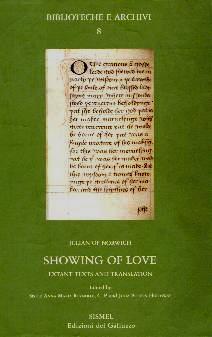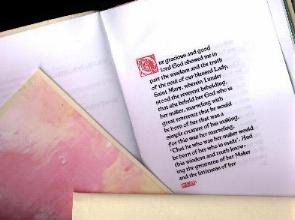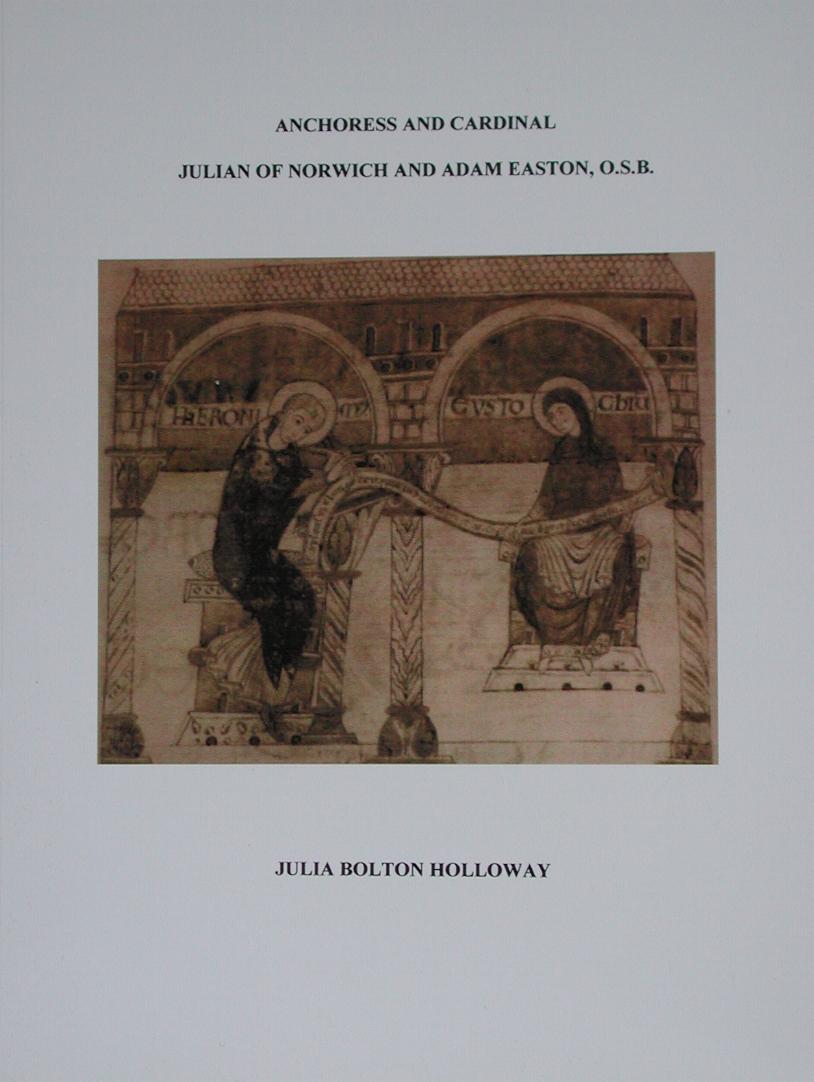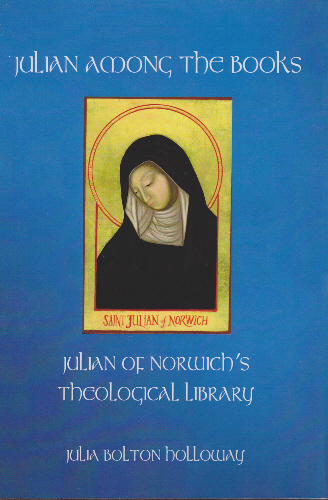St Birgitta: Relics (original) (raw)
JULIAN OF NORWICH, HER SHOWING OF LOVE AND ITS CONTEXTS �1997-2024 JULIA BOLTON HOLLOWAY || JULIAN OF NORWICH || SHOWING OF LOVE || HER TEXTS || HER SELF || ABOUT HER TEXTS || BEFORE JULIAN || HER CONTEMPORARIES || AFTER JULIAN || JULIAN IN OUR TIME || ST BIRGITTA OF SWEDEN || BIBLE AND WOMEN || EQUALLY IN GOD'S IMAGE || MIRROR OF SAINTS || BENEDICTINISM || THE CLOISTER || ITS SCRIPTORIUM || AMHERST MANUSCRIPT || PRAYER || CATALOGUE AND PORTFOLIO (HANDCRAFTS, BOOKS ) || BOOK REVIEWS || BIBLIOGRAPHY ||
ST BIRGITTA OF SWEDEN:
HER RELICS

Bishop Hemming of Turku, Finland, St Birgitta of Sweden, Urdialu, Finland

Birgitta of Sweden, Revelationes , Autograph Manuscript on Sienese Paper, Royal Library, Stockholm, Sweden
 t Birgitta of Sweden is especially celebrated this Jubilee of the Third Millennium of Christendom for her indefatigable work for Christendom, her vast book and her pilgrimages across the length and breadth of Europe and beyond, even to Jerusalem itself. Her remains have been carefully treasured for these six centuries. Though she was of noble birth, these remains are such simple things as a patched cloak made from an old dress, in which she used herself to beg amongst other beggars outside the Clarissan St Lawrence in Panisperna in Rome, while mending and patching her colleagues' scant garb, and a pilgrim's bowl of wood.
t Birgitta of Sweden is especially celebrated this Jubilee of the Third Millennium of Christendom for her indefatigable work for Christendom, her vast book and her pilgrimages across the length and breadth of Europe and beyond, even to Jerusalem itself. Her remains have been carefully treasured for these six centuries. Though she was of noble birth, these remains are such simple things as a patched cloak made from an old dress, in which she used herself to beg amongst other beggars outside the Clarissan St Lawrence in Panisperna in Rome, while mending and patching her colleagues' scant garb, and a pilgrim's bowl of wood.
This essay reviews two important books on St Birgitta's relics: Aron Andersson and Anne Marie Franz�n, Birgittareliker (Swedish and English) (Stockholm: Alqvist & Wiksells, 1975); Artur Bygd�n, Nils Gustaf Gejvall, Carl Herman Hjortsj�, Les Reliques de Sainte Brigitte de Su�de: Examen m�dico-anthrologique et historique (French); Heliga Birgittas Reliker (Swedish) (Lund: C.W.K. Gleerup, 1954).
The first relic discussed by Aron Andersson and Anne Marie Franz�n is a delicately made cap which would have been worn by Birgitta under her white and black widow's veil. It is smocked and gathered from two pieces of linen cloth and tied under the chin, which would have been hidden beneath Birgitta's customary white wimple. We see a similar cap in the Via Veritatis fresco in the Dominican Spanish Chapel in Florence being worn by her daughter, St Catherine of Sweden. these were likely made by St Birgitta herself. The relic is treasured at Maria Refugie, Uden, Holland, coming there from the suppressed Brigittine Marienforst, near Bonn, founded in 1450.
 Queen Joan of Naples, Sts Catherine and Birgitta of Sweden, Lapa Buondelmonte Acciaiuoli. Ediz. Giusti di S. Becocci, Firenze.
The second relic is St Birgitta's cloak. It was patched together from an old dress and its inside clearly shows the patchwork. A reconstruction of the dress from which it was made has found that it is that worn in Pierpont Morgan Manuscript illumination of Birgitta writing the Revelationes. Birgitta would beg with paupers outside San Lorenzo in Panisperna in Rome, mending the other beggars' clothes, the Florentine Paradiso document written out by Johannes Johannis Kalmarnensis tells us.
Admirabilis et spectate humilitatis extitit, ita ut nonnunqaum cum pauperibus peregrinis incognita simul sedens apud monasterium Sancti laurencii in panisperna de urbe ordinis Sancte clare elemosinam reciperet, et oscularetur cum graciarum actionem. Et frequenter propriis manibus, et ob dei reverenciam reparabat pauperum vestimenta.
She also sewed together the two scraps of Sienese-water-marked paper of her autograph text. One vision has her be chided for not mending her daughter's clothes. And in another account it is her daughter's shabby sleeves that become involved in a miracle. A group of noble Roman ladies take the poor but very beautiful Catherine of Sweden to the Vendemmia, the grape-harvesting, and as she is picking them they see her shabby sleeves instead as silken ones and embroidered with gems. In a manuscript written out in 1427 and sent by Vadstena to Thomas Gascoigne, Chancellor of Oxford (today, Oxford, Bodleian Library Digby 172B), one can see in the margin not the usual drawing of a pointing hand, but two hands lifted up garbed in delicate sleeves and in their fingers a bunch of grapes, beside the text of the account of this miracle.
Queen Joan of Naples, Sts Catherine and Birgitta of Sweden, Lapa Buondelmonte Acciaiuoli. Ediz. Giusti di S. Becocci, Firenze.
The second relic is St Birgitta's cloak. It was patched together from an old dress and its inside clearly shows the patchwork. A reconstruction of the dress from which it was made has found that it is that worn in Pierpont Morgan Manuscript illumination of Birgitta writing the Revelationes. Birgitta would beg with paupers outside San Lorenzo in Panisperna in Rome, mending the other beggars' clothes, the Florentine Paradiso document written out by Johannes Johannis Kalmarnensis tells us.
Admirabilis et spectate humilitatis extitit, ita ut nonnunqaum cum pauperibus peregrinis incognita simul sedens apud monasterium Sancti laurencii in panisperna de urbe ordinis Sancte clare elemosinam reciperet, et oscularetur cum graciarum actionem. Et frequenter propriis manibus, et ob dei reverenciam reparabat pauperum vestimenta.
She also sewed together the two scraps of Sienese-water-marked paper of her autograph text. One vision has her be chided for not mending her daughter's clothes. And in another account it is her daughter's shabby sleeves that become involved in a miracle. A group of noble Roman ladies take the poor but very beautiful Catherine of Sweden to the Vendemmia, the grape-harvesting, and as she is picking them they see her shabby sleeves instead as silken ones and embroidered with gems. In a manuscript written out in 1427 and sent by Vadstena to Thomas Gascoigne, Chancellor of Oxford (today, Oxford, Bodleian Library Digby 172B), one can see in the margin not the usual drawing of a pointing hand, but two hands lifted up garbed in delicate sleeves and in their fingers a bunch of grapes, beside the text of the account of this miracle.
In Birgitta's vision of Nicolo Acciauoli 's death and judgment, Revelationes IV.7.22-30, Mary appears in her humble cloak of mercy, beneath which the Dominican Friends of God and the Carthusians of Florence's Certosa, which he had built, gather and pray for his soul.
22 Plus dicimus: si res illa quam pre omnibus diligis, que est virgo que te genuit et que nunquam peccauit, si, inquam, illa peccasset mortaliter et sine contricione diuina mortua fuisset, 23 sic diligis iusticiam, quod anima eius nunquam obtineret celum sed esset nobiscum in inferno. Ergo, o iudex, cur non iudicas animam istam nobis, ut puniamus eam secundum opera sua?" 24 Post ista audiebatur sonitus quasi tube, quem qui audiebant tacuerunt, et statim quedam vox loquebatur dicens: "Silete et auscultate, omnes vos angeli et anima et demonia, quid mater Dei loquitur!" 25 Et statim ipsa virgo ante sedem iudicii apparens et habens sub mantello suo quasi occulte res aliquas magnas dixit: "O, o inimici! Vos persequimini misericordiam et cum nulla caritate diligitis iusticiam. 26 Licet in operibus bonis hic appareat defectus, pro quibus hec anima non debet obtinere celum; videte tamen quid ego habeo sub mantello meo!" Cumque virgo ambas aperuisset sinus mantelli, apparuit sub una quasi quedam modica ecclesia, in qua aliqui monachi videbantur. 27 Sub alia vero sinu apparuerunt mulieres et viri amicique Dei religiosi et alii; et omnes una voce clamabant dicentes: "Miserere, misericors Domine!" 28 Deinde factum est silencium, et virgo loquebatur dicens: "Scriptura dicit: Qui habet fidem perfectam potest per eam montes transferre in mundo. Quid ergo tunc possunt et debent voces istorum facere, qui et fidem habuerunt et seruierunt Deo cum feruenti caritate? 29 Quid vero illi amici Dei facturi sunt, quos iste rogauit orare pro se, ut posset separari ab inferno et obtinere celum, nec pro bonis operibus suis aliam remuneracionem quesiuit nisi celestia? 30 Numquid non possunt et valent omnes eorum lacrime et preces apprehendere et eleuare eum, ut obtineat ante mortem suam diuinam contricionem cum caritate? This relic, this black cloak made of patchwork from an old dress, labelled 'Mantello Di S. Brigida Vedova', is now treasured at Santa Lucia in Selci, but was originally granted to the Clarissans of San Lorenzo in Panisperna where the Saint had begged, and where her body had lain in state, and where she was initially entombed in a recycled pagan marble sarcophagus ('flesh eater') sculpted with cupids still in that church.

One can also see at San Lorenzo in Panisperna the grill to which the Clarissan Francesca de Sabellis crawled to be near the body of the saint that night, in the morning finding herself cured. I give here the text concerning that miracle from the document written by the Brigittine Johannes Johannis Kalmarnensis, formerly preserved at the Brigittine Paradiso in Florence and now in the Florentine State Archives.
Verum francisca de sabellis dicti monasterii sancti laurencii monialis, que biennio debilitatem et adversam stomachi valitudinem passa, fere semper lecto ducubuerate infirma, et honorande vidue familiaris fuerat dum adhuc insepultum corpus intra claustrum servaretur cum gravi labore de lecto surrexit, tam longam infirmitatem paciens, et adiuta pervenit ad ferretrum et secus illud jacuit tota nocte, nec deum desiit cum devocione et instancia deprecari que meritis et precibus Vidue cuius corpus aderat, tam molesta, tamque diutina valitudine in tantum saltem alleviaretur, que cum reliquis monialibus divinis officiis interesse, et per claustrum cum expediret adiuta per neminem, ire posset, et mane facto repperit se circa proprii sanitatem corporis efficacius remedium quam deprecata fu [fol. 7]erat impetrasse. But the grill's photograph is not given in this book. I have seen it instead in a Swedish study of Birgitta byIsak Collijn , whose study of the Italian archival materials is of the greatest use. And I have seen it in reality in that now neglected church today abandoned by its Clarissans.
At the Church of Santa Brigida in Rome are kept her hair shirt and the board of walnut, the size of a refectory table, on which she ate, wrote, and on which, it is said in the manuscript given to Thomas Gascoigne, she was laid at her death. Fragments of this board are kept in reliquaries in many places.

Margery Kempe tells us she stood in this room in Rome, by the English College, for she kneeled there on the stone on which Christ stood in the vision to Birgitta announcing her death, and she would have seen this tawny board.
._ _
_ 
Birgitta's vision as a child of Christ bleeding, announcing she is his Bride, a vision to a
disciple who sees her with seven tiaras, the dictation to her of the Revelationes by Jesus and
Maryand finally Christ's appearance to her in her oratory telling her of her coming death.
Perhaps Julian also did. For she describes it in theShowing of Love.
� For I thought I would not for my life have seen it fall. How it was done I saw not. But understood it was with the sharp thorns and the boistrous and grievous setting on of the Garland unsparingly and without pity. This continued awhile and soon it began to change. And I beheld and marveled how it might be. And then I saw it was, for it began to dry, and ceased a part of the weight and set about the garland. And thus it environed all about, as it were, garland upon garland. The Garland of the Thorns was dyed with the blood and the other garland and the head was all one colour as clotted blood, when it is dry. The skin of the flesh that was gashed of the face and of the body was in small wrinkles with a /S/ tanned /P/ tawny /SP/ colour like a dry board when it is /S/ kilned /P/ aged. /SP/ And the face more brown than the body. I saw four manner of dryings. � The first was bloodless. � The second was pain following after. � And third /P/ is that he was /SP/ hanging up in the air as men hang a cloth to dry. � The fourth, that the bodily nature asks for liquid. And there was no manner comfort ministered to him /S/ in all his woe and disease. /SP/ Ah, hard and grievous was his pain. But much harder and more grievous it was, when the moisture failed, and all began to dry, thus shriveling. These were /S/ the /P/ two /SP/ pains that showed in the blessed head.
The fifth relic discussed is St Birgitta's pilgrim bowl of birch or maple preserved at the Brigittine Priory in Altomunster. I have held it in my hands and it is exactly the dimension of one's hands cupped for holding water. It has an inscription in Cyrillic: ' estj iesus nazarenus rex iudeorum', the inscription on the cross given in John 19.19, preceded by ' estj' 'it is, this is'. On its bottom a date is given, letters being also numbers in Old Church Slavonic as in Hebrew, of 'SXYS', which translates as being of A.D. 1188 (6696-5508=1188).
This simple wooden bowl would have come to St Birgitta from a Slavic region both under Catholic and Orthodox influences since it gives a Latin text in Cyrillic letters. Perhaps it is a gift from Bishop Hemming of Turku or from Birgitta's brother, Israel, both of whom had dealings with Slavic Baltic areas. It was likely not a drinking bowl, though a late Italian inscription on it says ' Ciotola doue beueua S: Brigida', but instead a Slavic Eucharist paten, Catholicism prohibiting these being made from wood, which Orthodoxy permitted. It likely journeyed with Birgitta from the Baltic regions to Jerusalem and back, surviving shipwreck.

Also preserved at Altomunster is St Birgitta's pilgrim staff of juniper wood, again which I have held in my hand, the two items passed to me by the Brigittine Prioress through the convent's grill.
Once preserved at Vadstena, but now, since the Reformation in Sweden, kept at the University Library at Uppsala is the book perhaps written by Thomas de Froidmont for his sister Margaret of Jerusalem, here attributed to St Bernard writing to his sister. The manuscript is from Spain, perhaps acquired by Birgitta on pilgrimage to Compostela there, perhaps given to her in Rome by the Spanish Bishop Hermit, Alfonso of Ja�n . It is bound in leather with a flap with an embroidered knop for a button such as we also see on the coif and mantle, and indeed on other Brigittine nuns' books. The manuscript's cover has written on it: ' Hunc librum qui intytulatur doctrina Bernardi ad sororem portavit Beata mater nostra sancta Birgitta continuo in sinu suo ideo inter reliquies suas asseruandus est'. Interestingly, if she were its original recipient, Margaret of Jerusalem , carried out the great pilgrimages Birgitta also did, to Compostela, Rome, Jerusalem. A later rendition of it into Middle English will immediately precede Julian of Norwich's Showing of Love in the Amherst Manuscript, there being called the Golden Epistle.

Uppsala University Library, C240, open to '{ Soror mea'
The second scholarly study of Birgitta's relics is of interest for showing both the sense of awe in which the bones of saints were held and the uses to which they could be put. When medical and anthropological scholars examined the contents of St Birgitta's Shrine in Vadstena they did not find a complete skeleton, but instead a conglomeration of bones, from different women and men, one labeled ' de sto sigfrido'.
Outside of that Vadstena Shrine relics were and are preserved in reliquaries. I have seen the arm reliquary kept in the Chapter Room at Altomunster Priory. Chancellor of Oxford, Thomas Gascoigne, (whose descendant, Margaret Gascoigne , was to copy out part of Julian of Norwich's Showing of Love), gave a relic of St Birgitta to Oseney Abbey at Oxford, noting that fact in a pastedown in the Syon Abbey Martilogy, a manuscript that then went to Lisbon and returned to England, being now in the British Library.
Let us turn back to our image of St Birgitta and the autograph scrap of her writing:

Bishop Hemming of Turku, Finland, St Birgitta of Sweden, Urdialu, Finland

Birgitta of Sweden, Revelationes , Autograph Manuscript, Royal Library, Stockholm, Sweden
This is Birgitta's iconography, of the saint poised, pen in hand, in the act of writing down her vision in her handwriting. In this Finnish diptych Birgitta is shown garbed in white with a black cloak, like a Dominican mantellata. Her other advisor when she was still in Sweden was Magister Mathias who studied in Paris with the Dominicans and was buried with them in Stockholm. It is just possible that Magister Matthias introduced Birgitta into the underground spiritual movement amongst the Dominicans, begun by Meister Eckhardt, influenced by his study of Marguerite Porete , and which spread throughout Europe amongst men and women Dominicans, and which was called the 'Friends of God '. The Paris Doctors of Theology, of all the Orders, Benedictine, Cistercian, Victorine, Augustinian, Carmelite, Franciscan, Dominican, had condemned Marguerite Porete to burning at the stake in 1310 for her book, The Mirror of Simple Souls. Birgitta and her daughter Catherine are presented in the scene in Dominican Santa Maria Novella and are associated with Dominican Catherine of Siena . Birgitta clearly uses the phrase 'Friends of God' and does so continuously in her Revelationes. Her great admirer, Chiara Gambacorta will become a Dominican Prioress who fills her convent with images of Birgitta writing and as Dominican.
Birgitta belonged, however, to all the great religious Orders of Europe. She began her ministry at Cistercian Alvastra and wrote her Rule modeled upon the Cistercian Rule. She borrowed as well from that of St Clare of the Franciscan Order. Her final editor, the Bishop Hermit Alfonso of Jaen , was associated with a now extinct Order, his brother Peter founding the Hieronymite Order of Hermits, of which a famous member would be the brilliant Sor Juana de la Cruz in Mexico City. Birgitta's greatest supporter would be the Benedictine Cardinal Adam Easton of Norwich, though during her lifetime Birgitta had been critical of Benedictine corruption, wealth and worldliness. Then, at the Reformation in Sweden, when State turned against Church. statues of Birgitta writing her Revelationes had her writing hand struck off, her books called in. Kings feared that prophetic hand's text. Her silver arm reliquaries, once treasured so greatly, tend to show her fingers delicately holding a lost quill. These relics can make her text, despite six centuries, tangible, present, human.
Thus in our study of texts we need, not only to study their contexts, and, in the case of a saint, the documents of their canonization, Birgitta's including the oral testimony of Flemish servant girls, Roman nuns, Swedish mothers and many more witnesses, but even the very garments, even the very bones, of their writers, to find these are interlaced through time and space, that such textual communities preserved scraps of parchment, of paper, of cloth, of wood, and of bone, holding these dearworthy where - especially - a woman saint has spoken and written, in Quaker parlance, 'Truth to Power'. Birgitta of Sweden, Europe's Co-Patroness, is present in these fragments, in our midst, everywhere, her patched cloak enveloping us all.

Detail, ' Birgitta's Vision at Bethlehem '. Chiara Gambacorta , whose father was with Birgitta in Jerusalem and Bethlehem, and who was a friend of both Alfonso of Jaen and Catherine of Siena, comissioned this portrait painting by Turino Vanni for her convent in Pisa, San Domenico. Now, Pisa, Museo Nazionale di San Matteo.
If only we had a similar tangible reality across six centuries, apart from our surviving texts, concerning Julian of Norwich and her friend Margery of Lynn. Our earliest manuscript of Julian of Norwich's Showing of Love contains Cistercian Thomas de Froidmont writing to his sister Margaret of Jerusalem; Marguerite Porete 's Mirror of Simple Souls; a fragment of the Horologium Sapientiae by the Dominican Friend of God Henry Suso who wrote for and about Elsbeth Stagel; a fragment from Birgitta of Sweden's Revelationes; Jan van Ruusbroec's Sparkling Stone, he a friend of the Friends of God; the English hermit Richard Rolle's writings for anchoresses, especially Margaret Kirkeby; and the English Carmelite Richard Misyn's translations of Richard Rolle for the anchoress Margaret Heslyngton; the manuscript then coming into Carthusian and Brigittine ownership. While Margery, also, was exposed to such a library of contemplative texts by Dominicans and Carmelites, her manuscript likewise being preserved by Carthusians. All of these women sought to gather the divisions of the Church under Mary's patchworked cloak, sewing together its pathetic tatters again into the love of God's Wisdom.
Indices to Umilt� Website's Essays on Julian:
Influences on Julian
Her Self
Her Contemporaries
Her Manuscript Texts **♫ with recorded readings of them
About Her Manuscript Texts
After Julian, Her Editors
Julian in our Day
Publications related to Julian:


Saint Bride and Her Book: Birgitta of Sweden's Revelations Translated from Latin and Middle English with Introduction, Notes and Interpretative Essay. Focus Library of Medieval Women. Series Editor, Jane Chance. xv + 164 pp. Revised, republished, Boydell and Brewer, 1997. Republished, Boydell and Brewer, 2000. ISBN 0-941051-18-8
 To see an example of a page inside with parallel text in Middle English and Modern English, variants and explanatory notes, click here. Index to this book at http://www.umilta.net/julsismelindex.html
To see an example of a page inside with parallel text in Middle English and Modern English, variants and explanatory notes, click here. Index to this book at http://www.umilta.net/julsismelindex.html
Julian of Norwich. Showing of Love: Extant Texts and Translation. Edited. Sister Anna Maria Reynolds, C.P. and Julia Bolton Holloway. Florence: SISMEL Edizioni del Galluzzo (Click on British flag, enter 'Julian of Norwich' in search box), 2001. Biblioteche e Archivi 8. XIV + 848 pp. ISBN 88-8450-095-8.
 To see inside this book, where God's words are in red, Julian's in black, her editor's in grey, click here.
To see inside this book, where God's words are in red, Julian's in black, her editor's in grey, click here.
Julian of Norwich. Showing of Love. Translated, Julia Bolton Holloway. Collegeville: Liturgical Press; London; Darton, Longman and Todd, 2003. Amazon ISBN 0-8146-5169-0/ ISBN 023252503X. xxxiv + 133 pp. Index.
 To view sample copies, actual size, click here.Julian of Norwich, Showing of Love, Westminster Text, translated into Modern English, set in William Morris typefont, hand bound with marbled paper end papers within vellum or marbled paper covers, in limited, signed edition. A similar version available in Italian translation. To order, click here.
To view sample copies, actual size, click here.Julian of Norwich, Showing of Love, Westminster Text, translated into Modern English, set in William Morris typefont, hand bound with marbled paper end papers within vellum or marbled paper covers, in limited, signed edition. A similar version available in Italian translation. To order, click here.
 'Colections' by an English Nun in Exile: Biblioth�que Mazarine 1202. Ed. Julia Bolton Holloway, Hermit of the Holy Family. Analecta Cartusiana 119:26. Eds. James Hogg, Alain Girard, Daniel Le Bl�vec. Salzburg: Institut f�r Anglistik und Amerikanistik Universit�t Salzburg, 2006.
'Colections' by an English Nun in Exile: Biblioth�que Mazarine 1202. Ed. Julia Bolton Holloway, Hermit of the Holy Family. Analecta Cartusiana 119:26. Eds. James Hogg, Alain Girard, Daniel Le Bl�vec. Salzburg: Institut f�r Anglistik und Amerikanistik Universit�t Salzburg, 2006.

Anchoress and Cardinal: Julian of Norwich and Adam Easton OSB. Analecta Cartusiana 35:20 Spiritualit�t Heute und Gestern. Salzburg: Institut f�r Anglistik und Amerikanistik Universit�t Salzburg, 2008. ISBN 978-3-902649-01-0. ix + 399 pp. Index. Plates.
Teresa Morris. Julian of Norwich: A Comprehensive Bibliography and Handbook. Preface, Julia Bolton Holloway. Lewiston: Edwin Mellen Press, 2010. x + 310 pp. ISBN-13: 978-0-7734-3678-7; ISBN-10: 0-7734-3678-2. Maps. Index.

Fr Brendan Pelphrey. Lo, How I Love Thee: Divine Love in Julian of Norwich. Ed. Julia Bolton Holloway. Amazon, 2013. ISBN 978-1470198299

Julian among the Books: Julian of Norwich's Theological Library. Newcastle upon Tyne: Cambridge Scholars Publishing, 2016. xxi + 328 pp. VII Plates, 59 Figures. ISBN (10): 1-4438-8894-X, ISBN (13) 978-1-4438-8894-3.

Mary's Dowry; An Anthology of Pilgrim and Contemplative Writings/ La Dote di Maria:Antologie di Testi di Pellegrine e Contemplativi.Traduzione di Gabriella Del Lungo Camiciotto. Testo a fronte, inglese/italiano. Analecta Cartusiana 35:21 Spiritualit�t Heute und Gestern. Salzburg: Institut f�r Anglistik und Amerikanistik Universit�t Salzburg, 2017. ISBN 978-3-903185-07-4. ix + 484 pp.
JULIAN OF NORWICH, HER SHOWING OF LOVE AND ITS CONTEXTS �1997-2024 JULIA BOLTON HOLLOWAY || JULIAN OF NORWICH || SHOWING OF LOVE || HER TEXTS ||HER SELF || ABOUT HER TEXTS || BEFORE JULIAN || HER CONTEMPORARIES || AFTER JULIAN || JULIAN IN OUR TIME || ST BIRGITTA OF SWEDEN || BIBLE AND WOMEN || EQUALLY IN GOD'S IMAGE || MIRROR OF SAINTS || BENEDICTINISM || THE CLOISTER || ITS SCRIPTORIUM || AMHERST MANUSCRIPT || PRAYER || CATALOGUE AND PORTFOLIO (HANDCRAFTS, BOOKS ) || BOOK REVIEWS || BIBLIOGRAPHY ||
